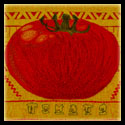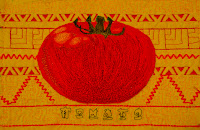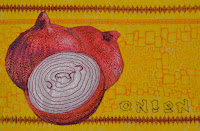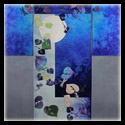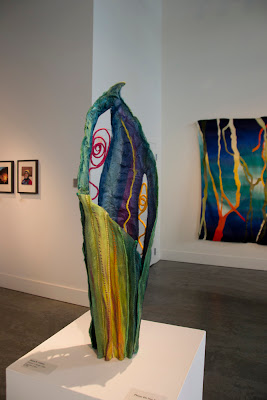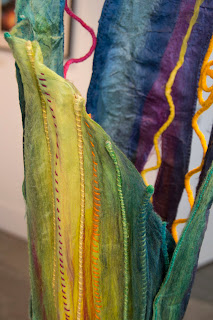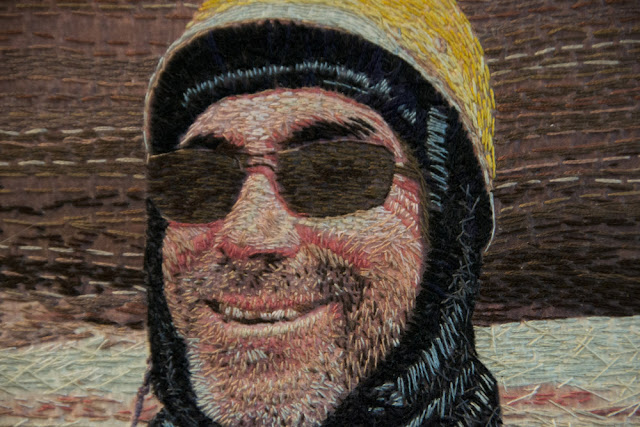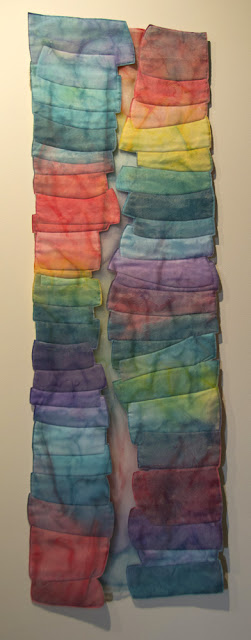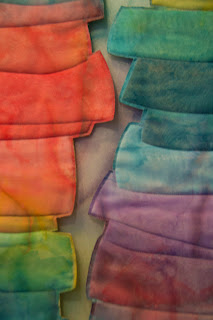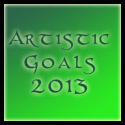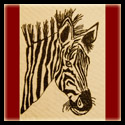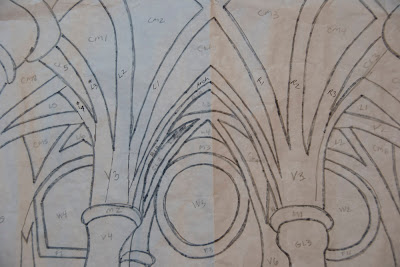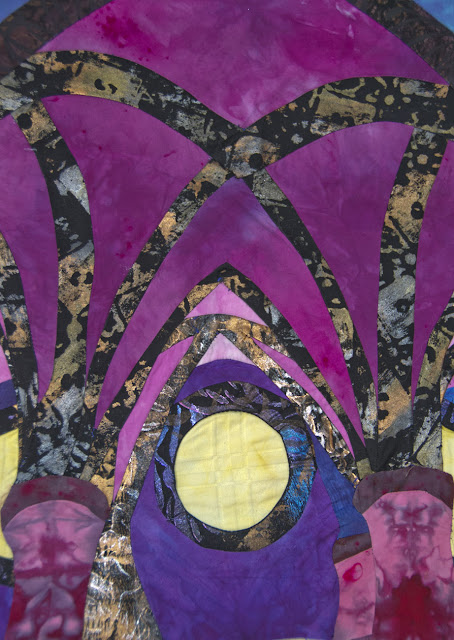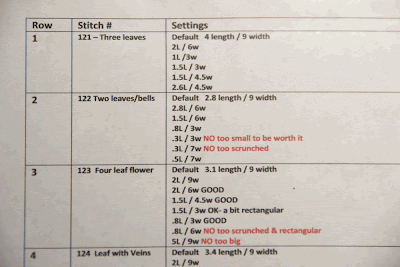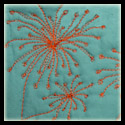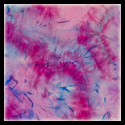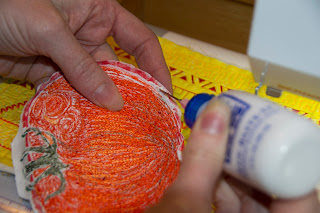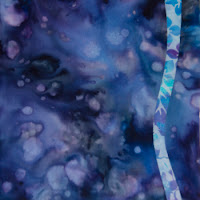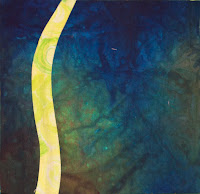 |
| Ryan Holdridge, Eagle Scout with Mom, Christina |
First and foremost… every mother deserves some bragging rights. Tonight, my son Ryan completed the final step and earned his Eagle Scout rank! We’ve been on that journey since 2001, including my being a den leader and assistant scoutmaster. Woo Hoo!!!
This week has been a bit of a push… Not only did I work on my UFO Waterfall quilt, I wanted to have my 5 x 7 Artist Challenge Piece be able to coordinate into the salsa quilt theme. I’m pretty excited about the result so far. I’ve decided to not finish the edges of these salsa blocks, since I will be piecing them together into a full quilt.
The process for making this started with a photograph of a tomato. Actually, I picked out photos for each of the nine items (tomato, onion, cilantro, peppers, tomatillo, lime, chili pepper, corn, and onion.). I then removed backgrounds and resized the photos to fit the 5 x 7 format in Photoshop. I then printed the photos (2 to each page) on COTTON from VV Prints -(add link and type of cotton).
 |
| Start of thread painting the tomato |
I keep my thread sorted by color, rather than type, with the exception of metallics. Since I decided to start with the tomato, I pulled out a wide range of reds and oranges, changing in value from tangerine and pinks, through the true hues, up to dark maroons and deep rusts. I placed them in a line of values- light to dark, so it would be easy to pick out which colors would be next in shading.
I then hooped my tomato. When you are doing machine embroidery, it’s important to use stabilizer (I used two layers-one of Pellon Stitch N Tear the second OESD Heavy-weight cut-away Embroidery stabilizer) to help ensure you embroidery won’t get misshapen. You also hoop opposite from the way you do with hand embroidery, so the fabric is laying along the bottom of the hoop, rather than across the top edge. This way the fabric is flush up against the sewing table.
the second OESD Heavy-weight cut-away Embroidery stabilizer) to help ensure you embroidery won’t get misshapen. You also hoop opposite from the way you do with hand embroidery, so the fabric is laying along the bottom of the hoop, rather than across the top edge. This way the fabric is flush up against the sewing table.
 |
| “Tomato” stitched on marked background |
I then started freemotion thread painting. I layered colors, particularly where I wanted to blend shading. I generally try to start with areas that would be further away from the viewer and end with the places that would be closest, the help create a more 3-D effect.
After completing the tomato, I turned to the background on which it would be placed. I knew I waned to have the names of each fruit or vegetable printed out on the background, so I decided to try my friend’s process for text (see note on how to do this with Marylee Drake’s ‘Celebration’ quilt.) I picked a fun Font to go along with the Salsa theme and stitched it onto the background.
 |
| Adding decorative stitching |
 |
| Added freemotion quilting |
 |
| Coloring edge of embroidery so it can be turned under |
Next, I marked my background with a Dritz Fine Line Water Erasable Marking Pen – Blue to help keep my lines well-spaced. I then added both machine decorative stitching and Freemotion quilting to the background that would accent and complement both the tomato and the Salsa theme. For the Freemotion quilting, I turned to Leah Day’s Freemotion Quilting Project and found a few designs that would give me the effect I wanted… To look like Mayan patterns. I decided on Square Shell (without filling in the small square), and a cross between Echo Maze and Circuit Board.
to help keep my lines well-spaced. I then added both machine decorative stitching and Freemotion quilting to the background that would accent and complement both the tomato and the Salsa theme. For the Freemotion quilting, I turned to Leah Day’s Freemotion Quilting Project and found a few designs that would give me the effect I wanted… To look like Mayan patterns. I decided on Square Shell (without filling in the small square), and a cross between Echo Maze and Circuit Board.
Finally, i colored the edges of the white fabric around the embroidery using a Stained by Sharpie Brush Tip Fabric Markers before I hand appliqued the tomato onto the background. I added two layers of batting between the embroidered tomato and the backing, with the first just slightly smaller than the size of the tomato, and the second a smaller oval, so it would help add a three-dimensional more rounded shape. I used Roxanne Glue Baste-It
before I hand appliqued the tomato onto the background. I added two layers of batting between the embroidered tomato and the backing, with the first just slightly smaller than the size of the tomato, and the second a smaller oval, so it would help add a three-dimensional more rounded shape. I used Roxanne Glue Baste-It to help hold the edges under as I appliquéd.
to help hold the edges under as I appliquéd.
 |
| My completed 5 x 7 piece “Tomato” |
The only step, other than finishing the edges, which I still need to decide whether to do or not is whether I’ll paint in the lettering. I’ve decided to hold off for now, as I want to test painting letters this size, before I try it on my finished piece.
 This week my blog was featured on FreeMotion by the River! Thanks, Connie!
This week my blog was featured on FreeMotion by the River! Thanks, Connie!
You might also be interested in:
Check out these great blogs I’ve linked up with!
Freemotion by the River
Nina Marie Sayre Quilt Art
Confessions of a Fabric Addict
QuiltStory
Richard and Tanya Quilts
Freshly Pieced- Work In Progress Wednesdays
Made by Me!
Quiltsy Check out the wonderful seed stitch info on their Jan 17, 2013 post.




